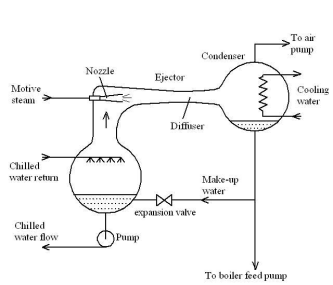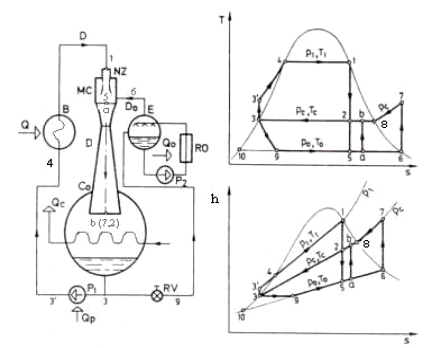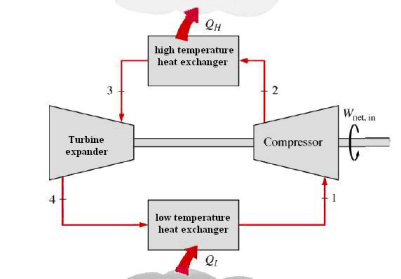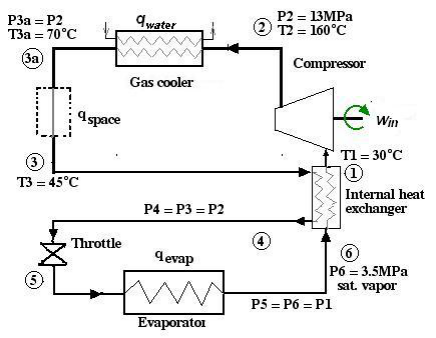苏ICP备112451047180号-6
1. Principles of vapor jet refrigeration systems
1。蒸汽喷射式制冷系统的原理
Vapor jet refrigeration is other type of vapor compression refrigeration cycle driven by heat source of high temperature. As the same as the mechanical vapor compression refrigeration cycle, the vapor jet refrigeration cycle can accomplish the removal of heat through the evaporation of a refrigerant at a low pressure and the rejection of heat through the condensation of the refrigerant at a higher pressure. The pressure difference in the system is created by a high pressure vapor or steam ejector, as shown in Fig.5-15.
蒸气喷射制冷是由高温热源驱动的其他类型的蒸汽压缩式制冷循环。作为机械的蒸气压缩式制冷循环相同,蒸汽喷射制冷循环可以完成通过在低压力和排斥反应的热量,通过在更高的压力的制冷剂的冷凝的制冷剂的蒸发器的除热。通过高压蒸汽或蒸汽喷射器,如在图15示出在系统中创建的压力差。
The refrigerant in the system shown in Fig.5-15 is water. A supply of high-pressure vapor, usually steam, passes through a nozzle in which it acquires a high velocity and some vacuum whilst expanding down to evaporator pressure. This steam, known as the motive steam, shares its momentum with vapor from the evaporator so that the resulting mixture has sufficient velocity to move against the pressure gradient up to the condenser pressure in a diffuser, in which the mixture is decelerated and compressed. Both the motive vapor and the vapor drawn from the evaporator are condensed, and the condensate is then divided into two flows, one to pass an expansion valve and feed the evaporator and the other to supply the boiler of motive steam through a feed pump.
在图15所示的系统中的制冷剂是水。甲供给的高压蒸汽,通常为蒸汽,通过它获得一个较高的速度和一些真空下降到蒸发器的压力,同时扩大的喷嘴。称为动力蒸汽,此蒸汽,股其动量与蒸汽从蒸发器,使所得到的混合物具有足够的速度,移动对最多在一个扩散器的冷凝器压力的压力梯度,在其中该混合物被减速和压缩。动机蒸汽和来自蒸发器的蒸汽被冷凝,冷凝液然后被分成两个流,一个通过一个膨胀阀和进给在蒸发器和其他通过进给泵提供动力蒸汽的锅炉。

Fig.5-15, refrigeration system using a steam ejector or thermo-compressor
图5-15,使用蒸汽喷射器或热压缩机的制冷系统
1. An analysis for a basic steam jet refrigeration system
2.一个基本的蒸汽喷射制冷系统的分析
The basic steam jet refrigeration system, seen in Fig.5-16, consists of the following components: an evaporator; a refrigerated object; a boiler; a nozzle, a mixing chamber; a diffuser; a condenser; an expansion valve; and pumps. The system operates as follows: Steam generated in the boiler at relatively high pressure expands through a nozzle with supersonic velocity into a chamber where low pressure (or vacuum) is created at the same pressure as in the evaporator. Refrigerant vapor (D0) then flows to the mixing chamber, and after mixing with the motive steam it is compressed in the diffuser until it reaches condensing pressure. Then the steam is condensed in the condenser where part of it is throttled and supplied to the evaporator while the rest is pumped back to the boiler.
基本的蒸汽喷射制冷系统,在图16看到,包括下列组件:一个蒸发器;冷藏对象;锅炉;的喷嘴,一个混合室,一个扩散器,冷凝器,膨胀阀和泵。该系统的操作如下:在锅炉中产生的蒸汽,在相对高的压力下通过在低压力(或真空)在蒸发器中在相同的压力下被创建成一个腔室的喷嘴与超音速膨胀。制冷剂蒸气(D0),然后流入到混合室,并与动力蒸汽混合后,它被压缩在扩散器内,直到它到达冷凝压力。然后,蒸汽被冷凝的冷凝器,在那里它的一部分被节流,并提供给蒸发器,而其余的被泵送回到锅炉。

Fig.5-16, a scheme of a steam jet refrigeration system and T-s and h-s diagrams of its cycle (B –boiler; E –evaporator; NZ –nozzle; MC –mixing chamber; Df – diffuser; Co –condenser; RV –expansion valve; P –pump; RO –refrigeration object)
图16,一个计划的蒸汽喷射式制冷系统,其周期Ts的和hs图(B-锅炉;蒸发器E-; NZ-喷嘴; MC-混合室; Df的 - 扩散器;有限公司 - 冷凝器; RV - 膨胀阀泵P-RO-制冷对象)
In the steam jet refrigeration system, when water is used as a refrigerant, the evaporating temperatures are higher than 0 °C. For lower evaporating temperatures other refrigerants (R134a, R717 and R142b etc.) are applied. The steam jet refrigeration system is suitable for large volume flow rates and a pressure ratio up to 8 for a single stage system.
在蒸汽喷射式制冷系统中,当使用水作为制冷剂,蒸发温度高于0℃。对于较低的蒸发温度,其他制冷剂剂(R134a,R717和R142b等)被应用。的蒸汽喷射式制冷系统是适合于大体积流率和压力比多达8个的单级系统。
The water steam jet system operates with a vacuum in the condenser. Therefore, the condenser must be equipped with a double stage air ejector to remove air which may leak through the seals during the system's operation, and also to expel air from the system's equipment during its first starting.
水蒸汽喷射系统的操作与在冷凝器中的真空。因此,冷凝器必须配备一个双阶段的空气喷射器,以除去空气,这可能通过密封件泄漏的系统的操作过程中,并且排出空气从系统的设备,在其第一次起动。
In the steam jet system the vapor power cycle (1-2-3-3'-4-1) and the refrigeration cycle (6-7-8-3-9-6) are realized simultaneously. This can be explained by the progressive, independent observation that the state of the motive steam and refrigerant vapor changes. Motive steam is expanded in the nozzle from point 1 to point 5, but after mixing with refrigerant vapor it is compressed from 5 to 2, or in the mixture from a to b. The motive steam in the cycle's expansion process generates work i = hl - h2 converted from the part of the heat q added to the working body. This work is transmitted in the mixing chamber to the refrigerant vapor, which is compressed from 6 to 7 in the diffuser, so i = h = h7-h6. The resulting change of the mixture in the diffuser for both stream of motive steam and refrigerant vapor is from point a to point b. The specific absorbed heat in the evaporator is qe= h6 – h9 = h6 - h3.
在蒸汽喷射系统的蒸汽动力循环(1-2-3-3'-4-1)的制冷循环(6-7-8-3-9-6)的同时实现。通过逐步的,独立的观察,这可以解释的状态的动力蒸汽和制冷剂蒸汽的变化。动力蒸汽膨胀从点1至点5的喷嘴,但与制冷剂蒸汽的混合后,它被压缩,从5到2,或在从a到b的混合物。循环的膨胀过程中产生的动力蒸汽工作=百升 - H2转换从加入的热量Q的工作体的一部分。这项工作是在混合室中传送到从6至7中的扩散器,它被压缩的制冷剂蒸气,因此i = H =为h7-为h6。漫射器,用于两个流的动力蒸汽和制冷剂蒸汽的混合物中产生的变化是从点a到点b的。具体的在蒸发器中吸收的热量是: qe= h6 – h9 = h6 - h3.
qe= h6 – h9 = h6 - h3.
o instead of the condenser and the evaporator in vapor compression refrigeration cycle.
1。的气体的绝热膨胀
的气体制冷循环的蒸气压缩式制冷循环是相当不同的。在循环中的制冷剂气体,而不是蒸汽或液体,有没有相位变化从蒸汽液体或反向。因此分别在气体制冷循环在高温和低温下的两个热交换器,而不是在蒸汽压缩式制冷循环中的冷凝器和蒸发器。
2. Gas Refrigeration cycle
2。燃气制冷循环
Generally speaking, the objective of gas refrigeration cycle is to cool aircraft and to obtain very low (cryogenic) temperatures after it is modified with regeneration. And the work output of the expander can be used to reduce the work input requirements to the compressor.
一般来说,气体制冷循环的目的,是冷却飞机和,得到非常低的温度(低温)的与再生后,它被修改。和工作的扩展器的输出可以被用来减少压缩机的工作输入要求。
The circuit diagram of a refrigerating system which uses the lowering of temperature produced by the expansion of air doing work on a piston expander or in a turbine expander is shown in Fig.5-19. Air from the cold room at point 1, temperature T1, pressure p1, is compressed to pressure p2, the temperature rising during the process by an amount depending on the way in which compression is performed. The air at point 2 enters a high temperature heat exchanger (a gas cooler) in which the gas is cooled at approximately constant pressure to temperature T3, a little above the cooling edium temperature. The air gas at point 3 is then expanded in a turbine or other work-producing device, and leaves at a temperature T4 low enough to refrigerate the cold room. In the cold room heat transfer to the air raises the temperature to T1 again.
在图19所示的电路图中的制冷系统,该系统使用的温度的降低所产生的膨胀空气的活塞膨胀或在透平膨胀做功。在此过程中,温度上升的量取决于进行压缩的方式,其中在点1处,温度T1,压力p1的,从冷室的空气被压缩到压力p2。第2点中的空气进入的高温热交换器(气体冷却器),其中气体被冷却在大致恒定的压力,温度T3,上面一点冷却edium温度。在点3,空气的气体,然后在涡轮机或其他工作产生的移动设备的扩大,和叶在足够低,以冷藏冷室的温度T4。在冷室中的热量转移到空气的温度升高到T1再次。
The work delivered by the turbine or other expanders can be used to provide part of the work required to drive the compressor. The two machines may then be directly coupled to each other. The remaining work required must be supplied from an external supply.
可以使用由涡轮机或其他扩展交付的工作,以提供所需要的工作的一部分来驱动压缩机。两台机器然后可以直接耦合到彼此。剩余的工作必须从一个外部电源供给。
For the air conditioning of aircraft, the pressure p1 is atmospheric pressure, the pressure in the cold space. No low-temperature heat exchanger is required because the low-temperature air comes into direct contact with the cabin, etc. being refrigerated. This form of the cycle is known as the ‘open’ type gas turbine plant, in which air at atmospheric pressure is compressed, raised in temperature by burning fuel in it, expanded in a turbine to atmospheric pressure, and finally discharged to the atmosphere.
对于空调的飞机,压力p1是大气压力下,在寒冷的空间中的压力。是必需的,因为低温空气直接接触,与机舱无低温热交换器,等被冷藏。这种形式的周期被称为“开放式”的类型的燃气轮机的植物中,在大气压力下的空气被压缩,通过燃烧燃料在它的温度升高,扩大涡轮大气压,并最终排放到大气中。

Fig.5-19, diagrammatic arrangement of an open type cold air system using turbo-machinery
图19,冷空气系统的开放式涡轮机械的布置示意图
A simple aircraft air refrigeration system is shown in Fig.5-20. Some of the high-pressure air from the discharge stream of a main compressor is bled off for the air refrigeration system. Hot air with state (2) is cooled in the heat exchanger by air coming from the inlet of the main compressor, and after expansion in an air turbine it enters into the cabin. The work from the air turbine drives a cooling air fan. This system is convenient to cool the cabin when the plane is on the ground.
一个简单的飞机的空气制冷系统的示出在图5-20。一些从排出流的主压缩机的高压空气放出的空气制冷系统。与状态(2)的热空气在热交换器中被冷却的空气,来自主压缩机的入口,并在空气涡轮机的膨胀后,它进入机舱。从空气涡轮机驱动器的工作的冷却空气风扇。此系统是方便的机舱冷却,当飞机在地面上。
4. Transcritical Carbon Dioxide (R744) Refrigeration Cycles
4。跨临界二氧化碳(R744)制冷循环
Although CO2 (R-744) was widely used as refrigerant in the early 20th century, its use disappeared from around 1940 with the advent of the fluorocarbon chemicals. Thus, when professor Gustav Lorentzen at NTNU/SINTEF in 1990s proposed to reconsider the use of CO2, it had been absent for almost half a century. Increasing focus on environmental issues of fluorocarbon chemicals created a strong interest in systems using natural refrigerants in general. [20]
CO2(R-744)虽然被广泛用作制冷剂在20世纪初,从1940年左右消失,其使用的氟化学品的问世。因此,当教授古斯塔夫Lorentzen在NTNU / SINTEF在20世纪90年代提出的CO2重新考虑使用,它已经缺席了几乎半个世纪。氟碳化学品对环境问题的日益关注创造了浓厚的兴趣,在一般使用天然制冷剂的系统。 [20]
Nowadays the intentions of governments worldwide to prohibit the use of CFCs and HCFCs has forced refrigeration engineers to search for new fluids to perform the cooling of enclosures such that there is no degradation of performance compared with that of the proven CFC and HCFC technology. Douglas M. Robinson and Eckhard A. Groll consider that a long term view of the series of regulations and replacement refrigerants indicates that manufactured substances which are used as refrigerants are only temporary solutions to the long term need of refrigeration and carbon dioxide is a substance which can be used as a substitute.[21] R744 is now being used in industrial systems (e.g. food distribution centre), retail applications (e.g. Chilled and frozen food storage using central plant systems), and plug in type systems (e.g. drinks machines) and heat pumps (especially in Japan).
如今,意图迫使世界各国政府禁止使用氟氯化碳和氟氯烃制冷工程师寻找新的流体进行冷却的外壳有没有退化的表现比公认的CFC和HCFC的技术。道格拉斯M.罗宾逊和埃克哈德A.格罗尔考虑的一系列法规和替代制冷剂,长远的观点表明,人造的物质被用作制冷剂的制冷和二氧化碳的长远需要的临时解决方案,是一种物质,它可作为替代品。[21] R744是目前正在使用中的工业系统(如食品配送中心),零售应用程序(例如,冰鲜及冷藏食品储存,使用中央工厂系统),插头类型系统(如饮料机)和热泵(特别是在日本)。
Compared to conventional refrigerants, CO2 has many advantages as a refrigerant. It is a stable substance with a minimal environmental impact (ODP=0, GWP=1) and higher cooling capacity (up to 6 times the capacity of R404a). Its good heat transfer performance makes smaller evaporators and condensers possible and its lower viscosity makes less pipe work pressure drop. [22] But CO2 also has some disadvantages, such as its low critical temperature, high pressures in refrigeration cycle and high coefficient of expansion. So CO2 refrigeration cycle is always in trans-critical operation in high ambient with air cooled condensers, which cause the capacity and COP reduction.
与传统的制冷剂相比,二氧化碳作为制冷剂具有许多优点。用最小的环境影响(ODP = 0,GWP = 1)和较高的冷却容量(高达6倍容量的R404a的),它是一种稳定的物质。其良好的传热性能使得可能更小的蒸发器和冷凝器,其粘度较低,使工作压力降减少管。 [22]但是,二氧化碳也有一些缺点,如低的临界温度,制冷循环回路中的高的压力和高的膨胀系数。因此,CO2制冷循环始终是在高环境温度与空气冷却冷凝器,造成的能力和COP减少跨临界操作。
Due to the critical point of CO2 (73.77 bar and 30.85℃) the refrigeration cycle has to be operated transcritically when the ambient temperature is near or higher than the critical temperature. Fig.5-21 shows the subcritical and transcritical operation of CO2. In this case the evaporation takes place at subcritical pressure and temperature and the heat rejection at supercritical state. As seen in Fig.5-22, the main components of a CO2 refrigeration cycle are compressor, gas cooler (instead of a condenser because of the supercritical heat rejection, which occurs sometimes), internal heat exchanger, expansion valve, evaporator and low-pressure receiver. At the transcritical cycle the compressor sucks refrigerant as superheated vapor and compresses to high pressure. At the supercritical pressure, the CO2 is cooled in the gas cooler by transferring a heat flux to the ambient climate. The CO2 is cooled down near to the ambient temperature. In the internal heat exchanger the high-pressure CO2 is cooled and the low-pressure CO2, as saturated vapor from the receiver, is superheated. Then the refrigerant is throttled to low pressure
. 由于二氧化碳的临界点(73.77酒吧和30.85℃)的制冷循环具有当环境温度接近或高于临界温度时,进行操作transcritically。图21示出的亚临界和跨临界操作CO2。在这种情况下,蒸发发生在亚临界压力和温度,并在超临界状态下的散热。可以看出在图22中,其主要构成的CO2制冷循环的压缩机,气体冷却器(而不是一个冷凝器,由于超临界热排斥反应,有时会出现),内部热交换器,膨胀阀,蒸发器和低压力接收器。在跨临界循环压缩机吸入制冷剂过热蒸汽压缩到较高的压力。在超临界压力下,二氧化碳的气体冷却器中被冷却,通过转移的热通量环境的气候。二氧化碳被冷却到室温附近。在内部热交换器的高压二氧化碳冷却的低压二氧化碳,作为从接收器的饱和蒸汽,过热。然后制冷剂节流至低压。

